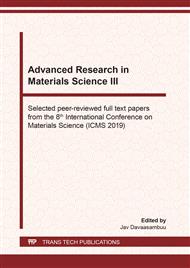p.96
p.101
p.109
p.118
p.124
p.134
p.140
p.145
p.150
Recognition of the Crystal Structure Clusters in Fast-Cooled Amorphous Medium
Abstract:
A series of computer experiments using the molecular dynamics method, imitating the processes of the argon particles system cooling at different cooling rates, was carried out. As a result of modeling, solid phases of varying degrees of order were obtained, a comparative analysis of structures was performed using the calculation of the radial distribution functions of particles and using the author’s algorithm for recognizing clusters of a crystal structure.
Info:
Periodical:
Pages:
140-144
Citation:
Online since:
September 2020
Authors:
Price:
Сopyright:
© 2020 Trans Tech Publications Ltd. All Rights Reserved
Share:
Citation:


